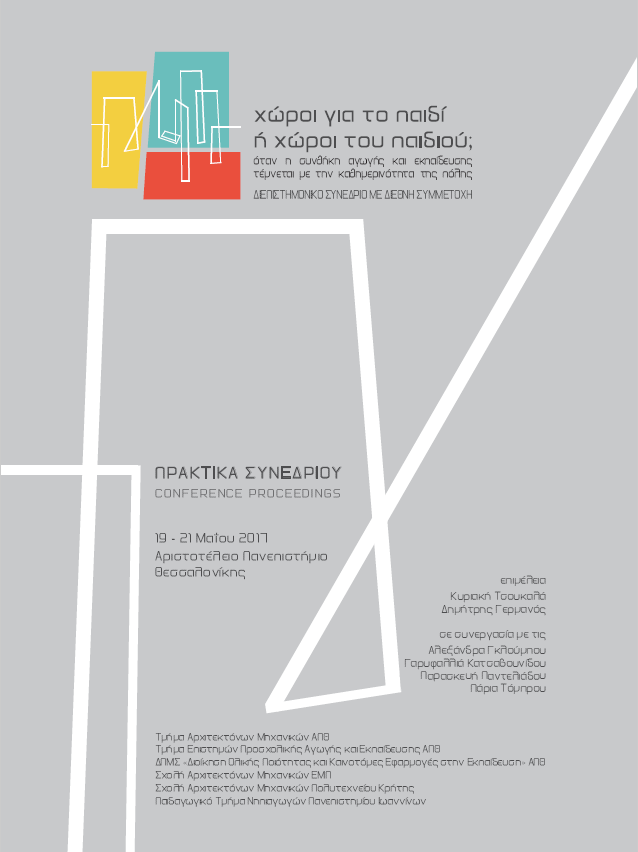«Τρόποι να κάθεσαι». Με εργαλείο το Design τα παιδιά διερευνούν τη βιωματική εμπειρία στην αντίληψη του χώρου

Περίληψη
Ο χώρος όπου κινείται το παιδί και τα αντικείμενα που το περικλείουν, δίνουν σημαντικά ερεθίσματα για τον τρόπο που το παιδί αντιλαμβάνεται τον κόσμο (Piaget & Inhelder 1985). Λαμβάνεται αυτό υπόψη στην εκπαίδευση; Οι δομές της εκπαίδευσης και της πόλης υιοθετούν νόρμες που εμποδίζουν την ελεύθερη και δημιουργική αναζήτηση νέων συνθηκών από το παιδί (Kirst 2005).
Η εργασία αυτή παρουσιάζει μια εκπαιδευτική εφαρμογή του καινοτόμου Εργαστηρίου Design για παιδιά, ηλικίας 9-11 ετών, που οργανώνεται και συντονίζεται από το Εργαστήριο Βιομηχανικού Σχεδιασμού του Τμήματος Εικαστικών & Εφαρμοσμένων Τεχνών Α.Π.Θ., στο πλαίσιο των εκπαιδευτικών προγραμμάτων του ΜΜΣΤ. Τα παιδιά, αξιοποιώντας τα εκπαιδευτικά εργαλεία του Design, πειραματίζονται με το χώρο, το σώμα, τα υλικά. Κατανοούν έννοιες όπως η ανθρωπομετρία, η εργονομία (Liamadis 2013), η κλίμακα, η αναλογία (Τσουκαλά 2000).
Η μελέτη περίπτωσης παίρνει ως αφορμή το ανοιχτό ερώτημα «τρόποι να κάθεσαι». Στο πλαίσιο αυτού, ζητούμενο δεν είναι ο σχεδιασμός μιας ακόμη καρέκλας σύμφωνα με τις υπάρχουσες θεωρήσεις, όσο η διερεύνηση της εμπειρίας στο χώρο. Οι διαφορετικές στάσεις καθίσματος αναδεικνύουν και διαφορετικές βιωματικές εμπειρίες στο χώρο. Τα παιδιά αναζητούν και σχεδιάζουν τρόπους του κάθεσθαι στην κλίμακα του αντικειμένου σύμφωνα με τις δικές τους διερευνήσεις, επιθυμίες και ανάγκες. Καταλήγουν, έχοντας αναδείξει νέους, οικειοποιημένους χώρους του παιδιού.Λεπτομέρειες άρθρου
- Ενότητα
- ΘΕΜΑΤΙΚΗ IV Εισαγωγή καινοτομιών για αναβάθμιση του εκπαιδευτικού περιβάλλοντος
Οι συγγραφείς των άρθρων που δημοσιεύονται διατηρούν τα δικαιώματα πνευματικής ιδιοκτησίας επί των άρθρων τους, δίνοντας το δικαίωμα της πρώτης δημοσίευσης.
Άρθρα που δημοσιεύονται διατίθενται με άδεια Creative Commons 4.0 και σύμφωνα με την άδεια μπορούν να χρησιμοποιούνται ελεύθερα, με αναφορά στο/στη συγγραφέα και στην πρώτη δημοσίευση για μη κερδοσκοπικούς σκοπούς.
Οι συγγραφείς μπορούν να καταθέσουν το άρθρο σε ιδρυματικό ή άλλο αποθετήριο ή/και να το δημοσιεύσουν σε άλλη έκδοση, με υποχρεωτική την αναφορά πρώτης δημοσίευσης στα πρακτικά.
Οι συγγραφείς ενθαρρύνονται να καταθέσουν σε αποθετήριο ή να δημοσιεύσουν την εργασία τους στο διαδίκτυο πριν ή κατά τη διαδικασία υποβολής και αξιολόγησής της.


